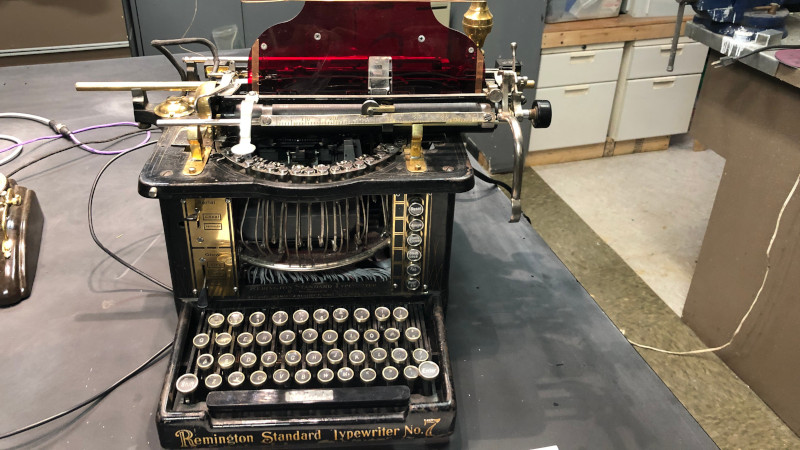Vintage typewriters can be beautiful and elegant devices. But there’s a limit to their value if, as with the 1903 Remington owned by [Daniel Ross], they are fire-damaged and have a seized mechanism. What did he do with what was essentially a piece of scrap metal? Produce an unholy mashup of the vintage machine and a 1988 Sharp daisy wheel typewriter to make a steampunk-style teletype, of course!
Stripping down both machines was evidently no easy task, and the result he’s achieved has the Sharp’s printer mechanism at 90 degrees to its original orientation sitting below the roller in the space once occupied by the Remington’s type bars. We’re sad to see that the keyboard on the older machine appears to be inoperable, but on the other hand each letter does light up as it’s typed.
Meanwhile at the electronics side the components from the Sharp have been transferred to a custom PCB, and the whole can be driven from a 300-baud serial line. As can be seen from the video below the break, the result is an unholy love-child of two typewriters that could scarcely be more different, but somehow it works to make an impressive whole.
If this project looks a little familiar to Hackaday readers, it’s because we’ve mentioned it in passing before. It’s hooked up to his COSMAC Elf retrocomputer, and we saw it in passing a couple of years ago at a much earlier stage of construction before the custom PCB and light-up keyboard.
















People wou ld use typewriters as keyboards, for CW or RTTY. Though I recall none used for printing.
My father had hacked a little electric typewriter to RS-232 in the 1980s. He used it for printing listings, among other things. That strange typewriter used thermal paper? Anyway, the keyboard was removed. He used it for other projects.
When I was little, I had hooked it up to my DOS PC and printed ASCII files to it via COPY command. It was accessible via AUX and COM1, I vaguely remember.
Awesome. Nicely done. If you had some Nixies or faux nixies on the front display showing the ASCII values we see on the red LED displays in the rear it would be cool (maybe even drive incan lamps from the diagnostic LEDs we see on the rear board??).
But very impressive.
Let’s don’t forget a little scope for the examining the RS-232 signals.
RTTY/Baudot equipment had them for displaying Mark/Space and the “RTTY cross” (Lissajous pattern).
Just to be clear, you mean a CRT ‘scope, right? Like a 1AP1 or 2AP1. Of course, it should be able to display either the serial data stream or vector-stroke characters.
I like!! Looks like it was a fun project.
I hope he has some documentation somewere, as the hackaday.io site is notorious for lacking that to the extend that jenny used more words than the original poster. I see some pictures of a eurocard stacked with ttl era chips, but no info on what it is or how it supposed to be working.
Or is that not the scope of hackaday.io?
Most of the time i immediately close the tab of a hackaday.io link, but once in a while i try to find some about the project on that horrible user interfarce to find out if something has changed, but alas, again not this time. I will take a next peek in august…
Hi, take a look at my video # 9. I do a more complete build documentation there.
as well schematics.
Arduino code on request.
https://www.youtube.com/results?search_query=nvictria+video++9
Jenny – if the typewriter hails from 1903, then technically it is not Victorian, a small detail missed by it’s creator. Possibly Edwardian?
Hi, the Remington #7 was first built in 1897, ( Victorian era) mine the serial # puts it in 1903, ( early Edwardian), so yes you are correct my TTY is in the Edwardian time..
But if you go by patent / and first release date then its clearly Victorian ( ended 1901)
Cheers
Daniel Ross
Those cross/Lissajous displays were not RS-232, they were the output of the MARK and SPACE filters in the modem. The display helped you to center the RTTY signal in th receiver passband by showing the relative amplitude of the detected signals…get them equal and hopefully peaked at same time, and you would get good copy
If it was within the realm of .. practicality to put LEDs under each key, it should be no more difficult to add capacitive touch sensors under them as well, and you go from an RO to a KSR Teletype.
Hello All, thanks for the comments.
I would like to point out that the keyboard does function, see my youtube video # 12 or # 13.
Also it does have a VFD display, nixie tubes are on the the main Cabinet CPU unit ( video # 6).
More documentation here at blogspot
https://mycosmac1802project.blogspot.com/2021/03/victorian-teletype-aka-steampunk-themed.html
Cheers
Daniel